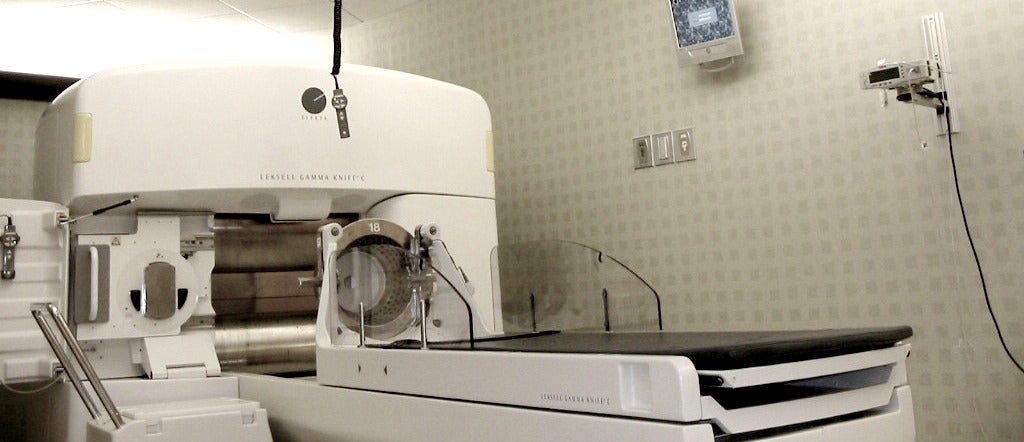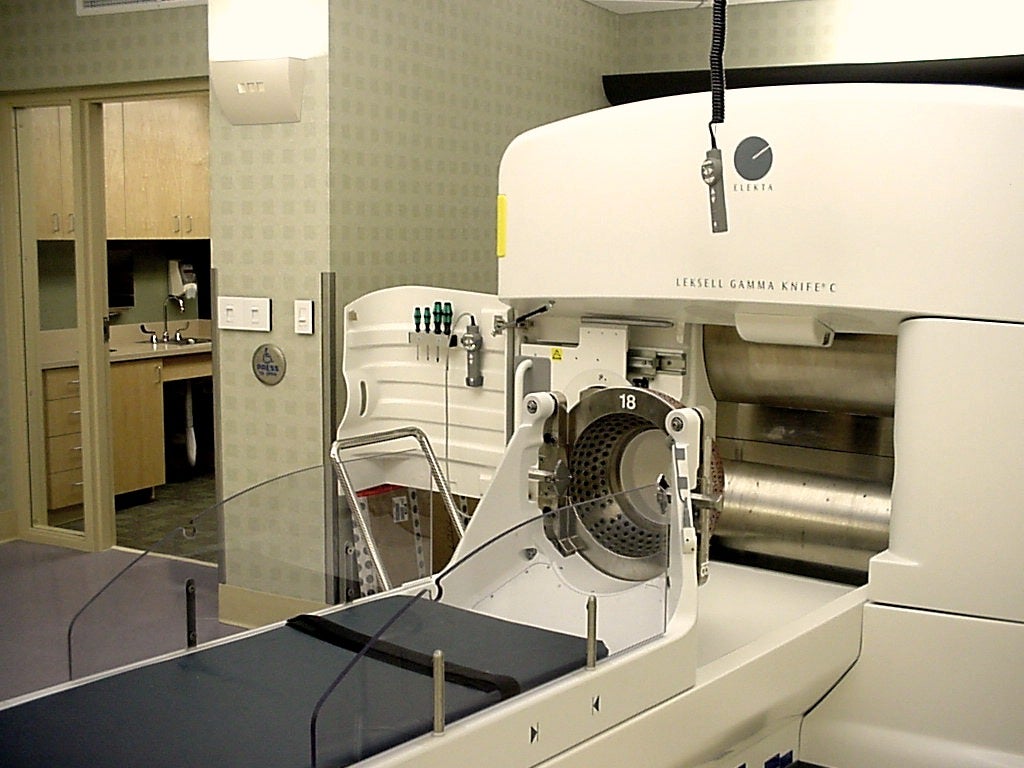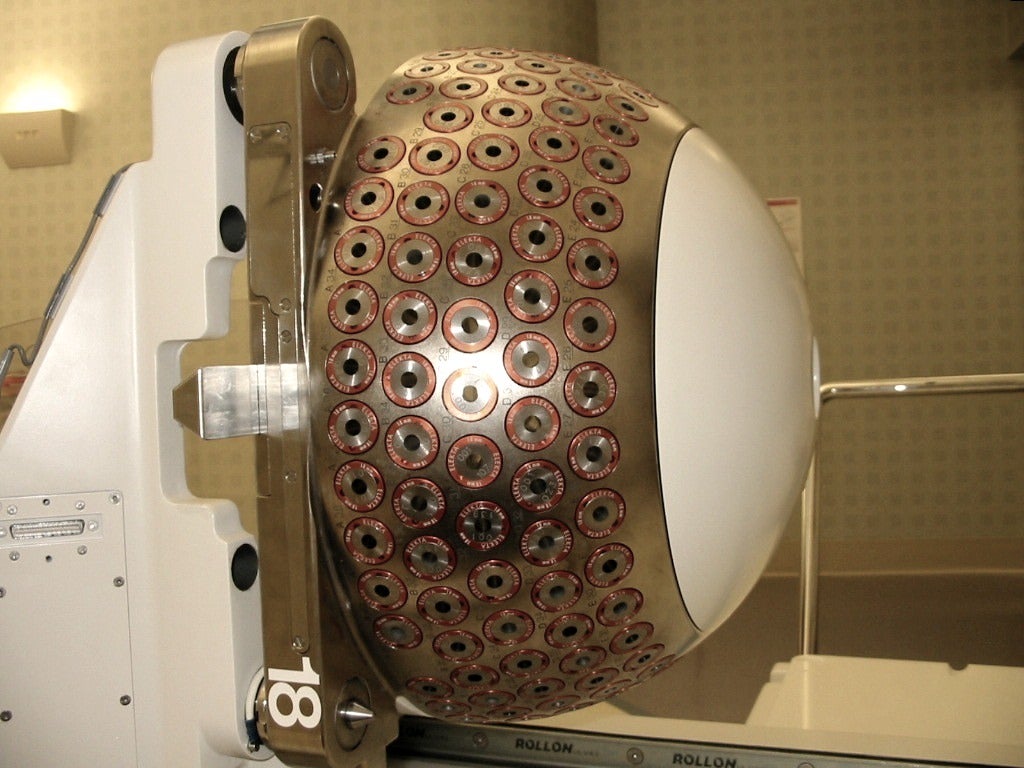
Lovelace Medical Center is the only hospital to offer Perfexion Gamma Knife® device technology to patients of New Mexico. Gamma Knife® is a device that is used for stereotactic radiosurgery, which is a special radiation treatment for small abnormalities or tumors of the brain. Lovelace Medical Group neurosurgeon Dr. Mark Bryniarski shares how the Gamma Knife® technology benefits patients and the team effort behind every treatment session.
“Gamma Knife® is a special radiation treatment because it is very precise,” says Dr. Bryniarski. “The device is centered around the patient’s head and the radiation beams are  focused on one point on the patient’s head where we would like to treat, which is planned in advance. The significant advantage of this device is the minimal radiation to the surrounding tissue. It is a very precise treatment, almost like a knife.” Another advantage is that this is an outpatient procedure, which means the patient does not have to stay in the hospital after treatment.
focused on one point on the patient’s head where we would like to treat, which is planned in advance. The significant advantage of this device is the minimal radiation to the surrounding tissue. It is a very precise treatment, almost like a knife.” Another advantage is that this is an outpatient procedure, which means the patient does not have to stay in the hospital after treatment.
When a patient arrives for treatment, a special frame is placed over the patient’s head with screws to hold it in place. Then the patient is taken to the MRI scanner and images or sequences are taken, which are then transferred to the computer station that is attached to the Gamma Knife® device. “Then the planning process begins,” says Dr. Bryniarksi. “We need to plan and specify the proper dosages and designate the exact area we want to treat with this radiation technology. Once the planning is done, the data is sent to the Gamma Knife® device itself and based on the computer calculations, the device sends those beams to treat the patient.” To receive treatment, the patient is placed in the device, which is similar to an MRI machine, and then the frames are attached, which serve as reference points.
 “Usually this is a one-time treatment session with one dose which can last anywhere between 45 minutes to multiple hours depending on the planned dosing,” Dr. Bryniarski says. “Once the treatment is complete, the frame is taken off of the patient, and they usually feel fine and can go home.” Almost every patient has follow-up MRI scans to see the results of the treatment. “For example, we can see whether the treatment helped to stop the growth of a tumor or if it has become smaller,” says Dr. Bryniarksi. “This whole treatment process requires multiple medical providers. At least one neurosurgeon, a radiation oncologist and a physicist all have their separate and overlapping roles to make sure everything is safe and goes according to plan.”
“Usually this is a one-time treatment session with one dose which can last anywhere between 45 minutes to multiple hours depending on the planned dosing,” Dr. Bryniarski says. “Once the treatment is complete, the frame is taken off of the patient, and they usually feel fine and can go home.” Almost every patient has follow-up MRI scans to see the results of the treatment. “For example, we can see whether the treatment helped to stop the growth of a tumor or if it has become smaller,” says Dr. Bryniarksi. “This whole treatment process requires multiple medical providers. At least one neurosurgeon, a radiation oncologist and a physicist all have their separate and overlapping roles to make sure everything is safe and goes according to plan.”
“The primary role of the neurosurgeon for the Gamma Knife® procedure is to make sure nothing is being radiated surrounding the treatment point that would damage important functions or alias regions of the brain,” explains Dr. Bryniarski. “The role of the radiation oncologist involves the proper dosing of radiation, using their experience from treatment of oncology patients. The physicist’s role is to make sure everything is safe throughout the whole treatment.” Gamma Knife® technology was established several decades ago, so there is a significant amount of data and literature behind the many advantages of this technology. “This is a beneficial treatment option because it is not open surgery, which carries higher risks for patients,” says Dr. Bryniarski. “It is an excellent choice for patients who are elderly and are not candidates for surgical approaches.”
point that would damage important functions or alias regions of the brain,” explains Dr. Bryniarski. “The role of the radiation oncologist involves the proper dosing of radiation, using their experience from treatment of oncology patients. The physicist’s role is to make sure everything is safe throughout the whole treatment.” Gamma Knife® technology was established several decades ago, so there is a significant amount of data and literature behind the many advantages of this technology. “This is a beneficial treatment option because it is not open surgery, which carries higher risks for patients,” says Dr. Bryniarski. “It is an excellent choice for patients who are elderly and are not candidates for surgical approaches.”
To learn more about Dr. Mark Bryniarski, please click here. To learn more about the Gamma Knife® procedure, please click here.




